The Top 50 Blue Cards
That's right, this time around we're doing things a little differently folks! When Aaron first approached me to write this article, he held one of my cats hostage. "Write me another Top 50 article for free and I'll think about letting Sir Charles live to sniff more catnip," he threatened. Well, I refused. After all, Sir Charles had woken me up the night before by lowering his ever-fragrant butt onto my face at three in the morning. But when my esteemed editor threatened action against lovely Xialou who would never, ever make me sniff his tush, I knew it was time for action. Summing up all my strength, all my action, all my prowess as a man, I swiftly ran to the computer, did hours of research, and came begging to Mr. Forsythe, sir, to let my cat go in exchange for the document before you.
Note: No cats, real or imagined, were hurt in the production of this riveting human drama.
What's this have to do with Blue Week? See, I was manipulated, had something of mine stolen, denied Aaron, and eventually will have my check from him bounce -- all characteristics of the color blue.
The Top 50 Blue Limited Cards of All Time!
What makes a great limited card? Is it the artwork? The name of the card? The copywrite line?
Good lord, no!
A great limited card will single-handedly win you games. These are known as "bombs." While Morphling might be a great constructed card (foreshadowing), it won't win games unless backed by counterspells and other blue accoutrements. In Urza Block limited, Morphling can come down on turn six and win on turn ten unassisted.
Keep in mind that not all limited formats are created equal! In that spirit, I give you the official rules of Ben's Top 50 Blue Limited Cards of all Time!
- This is my list, and is in no way official. All cards are in and of my opinion, and in no way reflect the opinions of a certain other Friday columnist on this site.
- Cards are ranked based upon a number of factors. Obviously better cards rank higher than not as good cards. However, in limited formats (Sealed Deck, Booster Draft and Rochester Draft to be specific), commons are a lot more relevant than uncommons, which in turn are more relevant than rares. This is because you are more likely to see a specific common in any given card pool than a specific rare. Therefore, commons are given more weight than uncommons, which are turn given more weight than rares.
- Mono-blue cards were the only cards considered. Some Invasion cards involving kicker made the list, but they all have blue borders. Gold-bordered cards such as Psychatog and Recoil were not up for bidding on this go-around.
- The only cards considered for this list were ones that were widely played in block limited formats. This includes Ice Age/Alliances, Mirage/Visions/Weatherlight, Tempest/Stronghold/Exodus, Urza's Saga/Urza's Legacy/Urza's Destiny, Mercadian Masques/Nemesis/Prophecy, Invasion/Planeshift/Apocalypse, Odyssey/Torment/Judgment, Onslaught/Legions/Scourge, and Mirrodin/Darksteel/Fifth Dawn and does not include base sets or pre-Ice Age sets. That's right, somewhere in this article are deep dark secrets about Mirrodin Block - secrets so hidden that you'd have to be making them up to find them!
On to the list!
50. Wind Spirit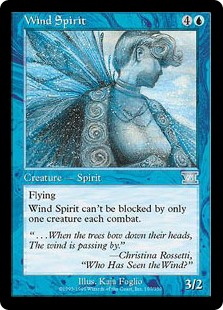
(Ice Age/Alliances)
Often people lament about the good old days of Magic, where men had hairs in unimaginable places, and Black Lotus made Lotus Petal look like Jeweled Amulet. So it comes as my pleasure to put Wind Spirit, everyone's favorite Covert Operative from the past, as number fifty on this list. Back in the day, people played Ice Age/Alliances sealed deck, and had to use the worst cards imaginable to win games. A 3/2 flyer that effectively couldn't be blocked was pretty much a bomb, since there were few removal spells, fewer fliers, and virtually no tempo in this format.
49. Thirst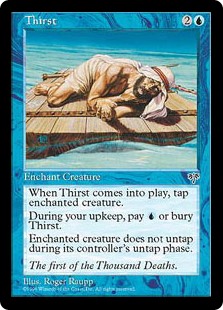
(Mirage/Visions/Weatherlight)
Blue doesn't get removal spells often, and they usually aren't in the common slot. That's what made Thirst special: unlike Frozen Solid and Dehydration, it tapped the creature RIGHT NOW, taking it out of combat for as long as you're willing to pay a blue mana. This cleared the way for attackers, and took care of bothersome utility creatures.
48. Illusionary Forces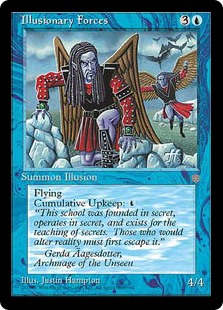
(Ice Age/Alliances)
What's better than a 3/2 flyer that can't be blocked for five mana? A 4/4 flyer that absolutely dominates the air for four mana. Sure, it might not stick around more than four turns because of the cumulative upkeep, but during that time the common Forces would eagerly serve up a healthy dish of twelve to sixteen damage unopposed.
47. Wormfang Crab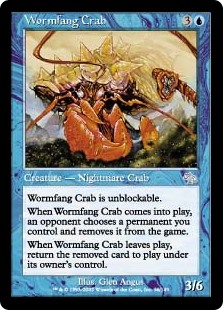
(Odyssey/Torment/Judgment)
The Crab came with a hefty drawback - your opponent got to zonk any problem card of their choice from your side of the board. In exchange, you got a huge (literally) creature for only four mana which broke stalemates and could play amazing defense if need be.
46. Soldevi Sage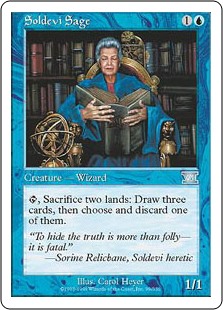
(Ice Age/Alliances)
Remember what I said above about Ice Age/Alliances having no tempo? This allowed Soldevi Sage to shine, since it had ample time to dig through your library for your best cards/answers to your opponent's problems. Lands often have no use late game in limited, so sacrificing a couple to give yourself a few extra cards never hurt, especially when the additional costs involved "tap" and not "spend mana".
45. Knight of the Mists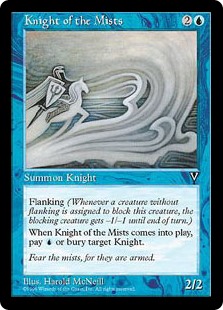
(Mirage/Visions/Weatherlight)
Visions gave all of the colors a lot of great 187 creatures - creatures which had comes-into-play effects. Nekrataal, Uktabi Orangutan, and Knight of the Mists were just three of these powerhouses. And just look at all the Knights in the format: Benalish Knight, Burning Shield Askari, Cadaverous Knight, Fallen Askari, Femeref Knight, Knight of Valor, Searing Spear Askari, Shadow Rider, Southern Paladin, Suq'Ata Lancer, Zhalfirin Commander, Zhalfirin Crusader, and Zhalfirin Knight. Every last one of the above creatures were good in limited, so having a creature which kills them all (and flanks itself to boot) would be considered gravy on the boat.
44. Veiled Serpent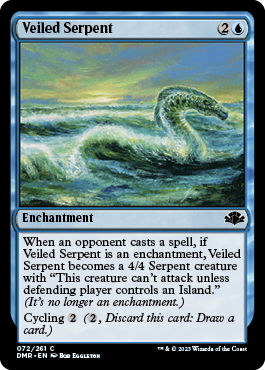
(Saga/Legacy/Destiny)
What's better than a 4/4 wall for three mana? How about a 4/4 wall that can attack if the opponent controls Islands, and cycles to boot! Because of the cycling, the Serpent was easily the best of the blue "sleeping" enchantments, able to completely stifle an opponent's offense early in the game.
43. Probe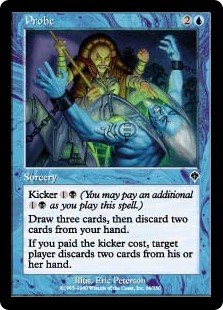
(Invasion/Planeshift/Apocalypse)
Without the kicker, Probe is a glorified Dream Cache, an ardently mediocre card. With the kicker, Probe begets massive card advantage, filtering three new cards through your hand while stripping your opponent of two of their own. Last I checked, Mind Rot plus Dream Cache would cost 

 and two cards, not
and two cards, not 

 .
.
42. Jilt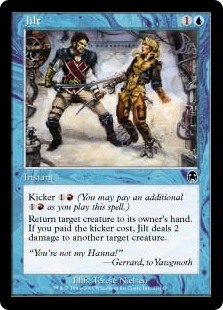
(Invasion/Planeshift/Apocalypse)
By the same token, without the kicker Jilt is an overcosted Unsummon - although I can't stress enough how important bounce spells are in limited for blue. They serve to give your side of the board tempo by allowing your creatures to attack (removing defenders), giving you more time to set up the board (removing attackers/expensive creatures), and allow for combat tricks (saving your creatures after damage is on the stack. as well as non-combat reuse of comes-into-play creatures (Jilt your own Flametongue Kavu, perhaps?) Barrin's Spite was a rare in this block and served generally the same purpose as Jilt, except that Jilt was an instant, and Jilt allowed you to unsummon your own creature if need be.
41. Day of the Dragons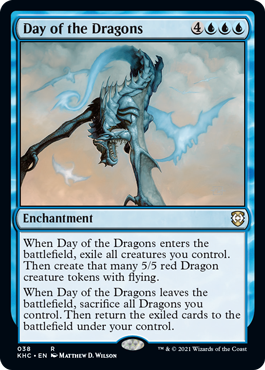
(Onslaught/Legions/Scourge)
The first rare "bomb" on this list, Day of the Dragons turns all of your creatures into 5/5 flying monsters. This card has two strikes against it: it costs triple blue to cast (just like cousin bombs Arcanis and Future Sight from this block) and blue is generally a weak color in Onslaught/Legions/Scourge.
40. Equilibrium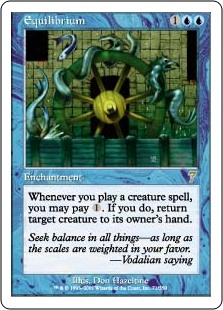
(Tempest/Stronghold/Exodus)
You'll hear me use the word "tempo" a lot when describing limited cards. This is because in most limited formats, there are opportunities to draft decks (or build decks) that maximize the mana curve so that you can steamroll your opponent before they even have a chance to set up a game. Blue bounce spells are the second best tempo cards in limited behind pure removal spells, so a reusable enchantment Unsummon dependent upon playing creature to begin with seems like a card that you'd like to have in your deck.
39. Wonder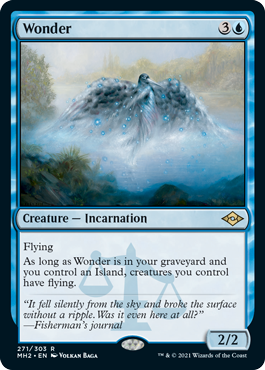
(Odyssey/Torment/Judgment)
Odyssey Block dealt heavily in the graveyard, between threshold, flashback, madness (discarding cards) and the Judgment Incarnations. Three best of these for limited were Glory, Genesis, and Wonder. Levitation was playable in Saga Block, cost four mana, and could be Disenchanted. Wonder costs zero mana, and can't be easily removed once in the graveyard. Zero mana effects which make all of your creatures into evasion creatures seem quite unfair. The only strike against Wonder is that the two best blue archetypes in OTJ draft were blue-white and blue-green, and blue-white decks tended to have mostly flying creatures to begin with, making Wonder often redundant.
38. Rushing River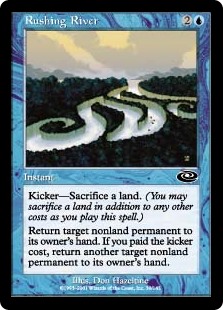
(Invasion/Planeshift/Apocalypse)
Why bounce just one creature when you can bounce a second for the cost of a land? Oh wait, did I say creature? I meant non-land permanent. Just to note, there were a ton of bounce spells in Invasion Block, and there are still more to come on this list. It speaks volumes of how deep the color blue went in Invasion Block given that this card wasn't even in the top three blue cards of the format!
37. Lost In Thought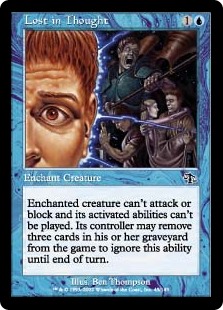
(Odyssey/Torment/Judgment)
Back in Mirage, Wizards created a removal spell for white called Pacifism. Pacifism really hit the flavor of white pretty well - it was removal that wasn't really permanent removal (Pacifism itself could be removed), but it kept the creature at bay indefinitely. Fast forward to Odyssey Block. In Judgment, Wizards decided that blue should give blue the best "Pacifism effect" in the block, beating Kirtar's Desire and Cagemail for utter efficiency. Blue mages rejoiced, and white mages wept, and blue-white mages had quite the identity conflict.
36. King Crab
(Saga/Legacy/Destiny)
Some blocks are about tempo, and others are about the swing factor. Urza's limited format was definitely a swing block - games often went back and forth. With the power level of most cards ratcheted up sky-high, bombs flew left and right, often swinging the game like a pendulum every turn. King Crab filled a very important niche for blue: a huge creature that could not only block opposing fatties, but send most of them straight back to the top of an opponent's deck. Many a green mage was seen conceding after they had no answers to a turn six King Crab with four green creatures already on the board. That's four turns of Time Ebb plus blocking - and losing that many draws in a row while your opponent continues to develop their board will not lead to many victories.
35. Palinchron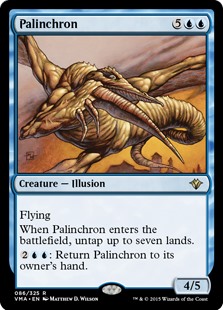
(Saga/Legacy/Destiny)
Some creatures were meant to kill, and others were born to be killed. Palinchron takes not dying to a new extreme by being able to bounce itself in the face of danger. Unlike other similar huge seven-casting cost flyers (Blizzard Elemental, anyone?), it gave you the mana on the turn you played it to save it!
34. Fact or Fiction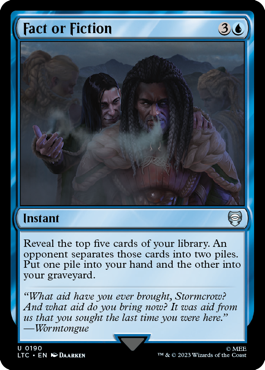
(Invasion/Planeshift/Apocalypse)
Drawing cards in any format can equate to victory, since the more cards you see each game, the more options you have to win. Fact or Fiction gives you five such options, reliant on an opponent's skill in splitting up piles in order to keep you from gaining the best of your spells. Just between you and me, there have been more wrong Fact or Fiction splits in Magic history than correct ones.
33. Propaganda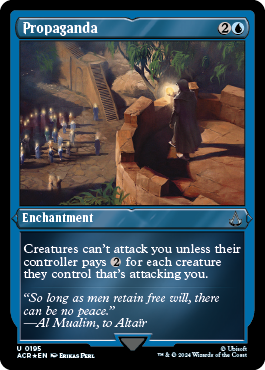
(Tempest/Stronghold/Exodus)
Many of you who are reading this column might not have been around for Tempest Block, so let me sum up the format for you: white and black had shadow creature, which couldn't block non-shadow creatures or flyers. Blue had flyers, which couldn't block shadow creatures, and green and red had non-shadow creatures which couldn't block shadow creatures or flyers. Because there was so little blocking going on, and because the creatures were so aggressively costed (you won't see too many two power evasion creatures for two mana anymore much less having multiples in the common slots of each color), games tended to end on turn five. This made green virtually unplayable in straight Tempest draft, and marginal by the time Exodus (and hence losing two packs of Tempest) came around. This also made blue the only option for slowing down the pace of the game, and Propaganda did just that. An opponent might get out a first turn Jackal Pup, follow it with a second turn Dauthi Horror, and cap those off with a Mogg Fanatic and Dauthi Slayer on turn three, but your third turn Propaganda would ensure that you didn't take a full seven damage to the noggin on turn four.
32. Counterspell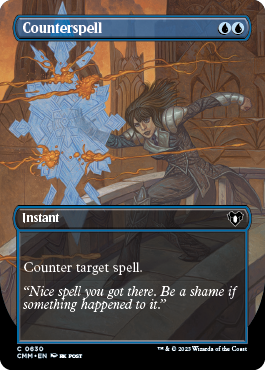
(Ice Age/Alliances, Tempest/Stronghold/Exodus, Masques/Nemesis/Prophecy)
Counterspells are decent in limited, but by no means the be-all, end-all of the universe. Early board development is essential to winning, and most (with an exception or two) reactive strategies fail no matter which limited format you're playing. So while Counterspell might be able to deal with any threat, most times you'd be better off drafting Dark Banishing or Incinerate so you could drop early creatures, and then use the removal to mop up afterwards instead of having to wait for your gracious opponent to walk into your untapped Islands.
31. Aboshan, Cephalid Emperor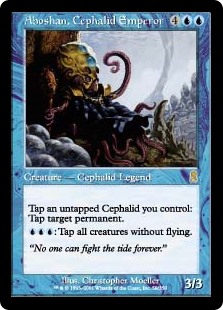
(Odyssey/Torment/Judgment)
If you opened up your first pack of Odyssey in an OTJ draft, there's few cards you'd want to draft over Aboshan. If you opened up a pack with Aboshan and Cephalid Looter, you'd likely draft Aboshan. So why did Looter finish higher? For one, Aboshan costs triple blue to activate. That's a heavy commitment to blue to take in the first pack. Aboshan dies easily for a six mana creature - that three toughness is below the threshold for red commons in the draft (Fiery Temper, Firebolt with flashback, Flame Burst with another Burst or Pardic Firecat in the yard, Acceptable Losses, Swirling Sandstorm, Kamahl's Sledge, Sonic Seizure, and Ember Shot will kill it), making it a little too fragile to survive in most instances.
30. Vodalian Illusionist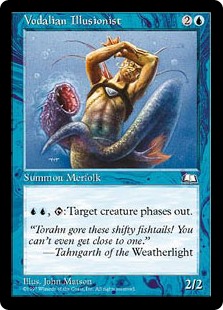
(Mirage/Visions/Weatherlight)
Part of the charm of bounce is that your opponent will have to reinvest resources to recast that creature a following turn. Another piece of the bounce equation is removing troublesome attackers or blockers. Vodalian Illusionist metes out this second stipulation of bounce quite well. Remember people: damage did not "go on the stack" back before Urza's Destiny. Creatures either dealt damage and received combat in damage, or didn't deal or receive damage - they couldn't deal damage and then be bounced afterwards. Vodalian Illusionist was pretty insane back in the day. Imagine how good his phasing ability would be with "damage on the stack" these days.
29. Mind Games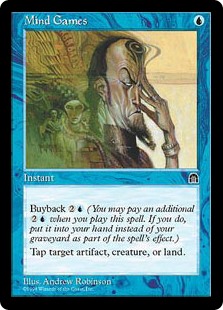
(Tempest/Stronghold/Exodus)
Remember how I mentioned that Blue was the color of slowing things down during the hectic days of Tempest Block limited? Mind Games fit this bill perfectly, allowing for the next best things to an Icy Manipulator. For four mana, one creature gets neutralized. For eight mana, two.
28. Waterspout Djinn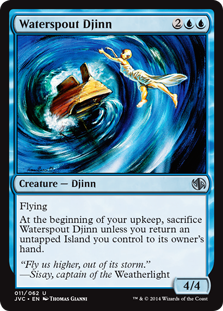
(Mirage/Visions/Weatherlight)
Evasion creatures win limited games, since there are few ways to block them. In constructed formats, you might be able to pack a red deck with thirty different ways to blast a creature to hell and back, but in limited you might only have two or three such spells. Because of this, creature combat happens a lot more often. This is why there is such a premium on flying and unblockable creatures - they are hard to kill in combat, the #1 way to kill creatures in sealed and draft. Waterspout Djinn clocks in at a hefty four power and toughness for only four mana. While it stifles your mana development, that won't matter if you can kill your opponent in just five quick attack phases. Think of the Djinn as Illusionary Forces with a different type of upkeep.
27. Rush of Knowledge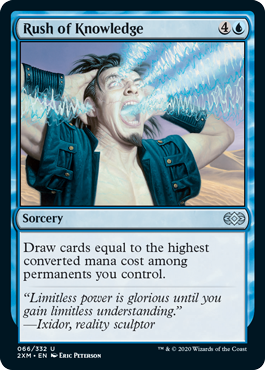
(Onslaught/Legions/Scourge)
The common consensus in Onslaught/Legions/Scourge draft was that you wouldn't want to play a deck with more than two colors, since there weren't many cards which allowed you to "mana fix" - that is, fetch a third color of mana. Invasion was filled with mana fixing cards, other sets had their Rampant Growth effects and even multiple-color unfriendly Odyssey had common lands which could be sacrificed for a third color in a pinch. Until the advent of land cycling creatures, Krosan Tusker and Explosive Vegetation seemed like the only feasible solutions to get a third color of mana in a draft. Landcyclers changed all this, since for two generic mana you could get whatever land applied to them. Suddenly you could splash Twisted Abomination and a single Swamp - if you drew the Swamp, you could play the Abomination, and if you didn't draw the Swamp and drew the Abomination, you could fetch the Swamp and thin your deck. This allowed players to draft Rush of Knowledge quite highly, and splash it into many decks that otherwise wouldn't have had blue. Drawing an average four to six cards for five mana is a backbreaker in limited, and having this in the common slot to boot didn't hurt matters much.
26. Disappear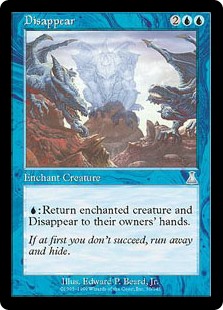
(Saga/Legacy/Destiny)
Buyback was supposed to be a Tempest Block mechanic, but Disappear borrowed heavily from that block to bring a reusable Unsummon to Urza's Destiny. While mana intensive, the ability to repeatedly refute an opponent's turn by bouncing their guy combined with the ability to use Disappear as a way to "protect" your creatures in combat (cast Disappear on it and then attack freely, knowing you can save it from lethal damage) made for a very potent enchantment that acted more as a sorcery than an enchantment.
25. Whispers of the Muse
(Tempest/Stronghold/Exodus)
Whispers of the Muse might be the definition of a perfectly balanced GOOD card drawing card. Unlike Treasure Trove, it can't be easily removed. It makes you manage your resources (six mana a turn) against drawing a card. It's a very strategic spell that can allow for massive card advantage given enough time. It also can be cycled for one blue in a pinch.
24. Coastal Piracy
(Masques/Nemesis/Prophecy)
Curiosity from Exodus just barely missed making the list. Coastal Piracy more than made up for this, by allowing each and every one of your creatures to draw you cards pending successful combat. Masques Block limited was defined by Rebel decks: you either had them or you had to have a way to beat them. Since blue had a disproportionate number of evasion creatures compared to the other colors in a block filled with very low-powered cards, Coastal Piracy allowed the blue mage to draw multiple cards a turn in the hopes of keeping up with the white mage and his ever-growing arsenal of tutored rebels.
23. Wash Out
(Invasion/Planeshift/Apocalypse)
Wash Out had one major problem: it was either really really bad or game-winningly good. Sometimes your opponent had out a single creature, and you'd be better off with Rushing River or some other instant bounce spell instead of a four mana sorcery. On the other hand, when Wash Out was good, it was amazing! It could return virtually every non-land permanent an opponent controlled in one fell swoop (and there are stories of people using Aurora Griffin to return the lands as well!), turning a stalemated game into an instant-win with your hordes now free to march unopposed through enemy territory. It could also buy you enough time by unsummoning a full horde of attackers against your slow board, allowing enough time for you to catch-up blockers to your opponent's fast start.
22. Willbender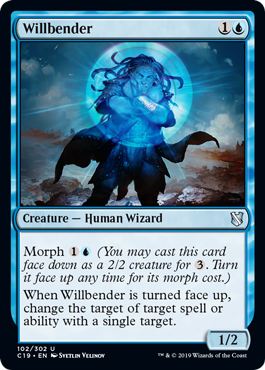
(Onslaught/Legions/Scourge)
Many people have commented that when Willbender is unmorphed, you win the game. This statement isn't far off from the truth. Meddle-like effects in limited have always been relatively strong, but Willbender takes this to a new level by allowing you to redirect spells AND effects. Suddenly, Sparksmith killed itself, Pinpoint Avalanche took out your opponent's best creatures instead of your best creature, and that Mythic Proportions your opponent just cast decided to enchant Willbender instead of your opponent's Taunting Elf.
21. Hermetic Study/Psionic Gift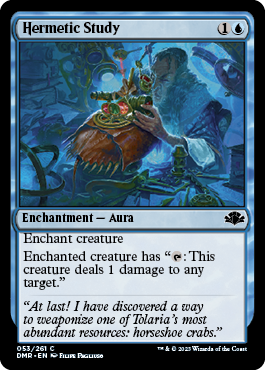
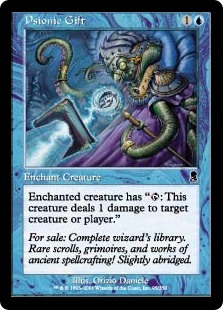
(Saga/Legacy/Destiny & Odyssey/Torment/Judgment)
In both sets, these cards served a similar purpose: kill small creatures or allow your smaller creatures to threaten large ones in combat (for instance, Hermetic Study would allow your 2/2 creature to attack into a 3/3 creature with the threat of your third Hermetic Studied creature sweeping away the 3/3 should it block). In Saga draft, it was a neat trick with Horseshoe Crab, creating what was known as "the Machine Gun." In Odyssey Block, it was said that if you didn't have at least one Psionic Gift in your white-blue deck, you didn't have a good white-blue deck. The bane of white-blue decks in that format was Cabal Torturer, and without Psionic Gift, the only good way to deal with this creature was to splash red or black as a third color, weakening your mana base.
20. Ovinomancer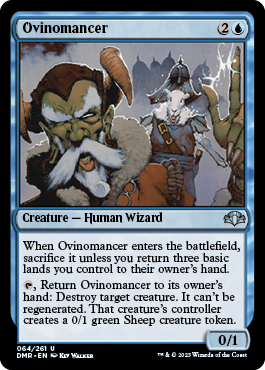
(Mirage/Visions/Weatherlight)
Black and Red might get reusable creature kill, but those usually are the only two cards to have this resource. Ovinomancer breaks this rule, but at a price: you have to stunt your mana development three turns each time it is cast. While this might seem harsh, the ability to kill any creature on the board at will can not be underestimated in limited. As well, once Ovinomancer was active, it was nigh-unkillable itself, since returning it to your hand is part of the cost and not effect.
19. Barrin, Master Wizard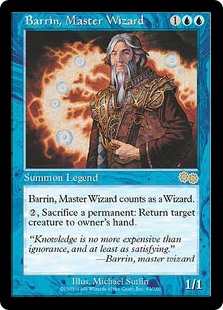
(Saga/Legacy/Destiny)
Barrin, Master Wizard, though a very fragile 1/1, basically turned every card on your side of the board into an Unsummon. If you waited until turn five to drop him, chances are he could protect himself. While in and of himself he would be a great card to have in limited, one of the block mechanics were "recurring" enchantments such as Rancor and Launch. These enchantments combined with Barrin made for unlimited bounce spells, as long as you had the mana. In addition, Barrin could bounce multiple creature a turn if need be, clearing the path for one fatal attack.
18. Cephalid Looter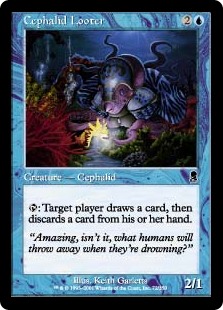
(Odyssey/Torment/Judgment)
The defining common for blue in Odyssey Block, Cephalid Looter interacted amazingly with flashback, threshold, madness, and the Incarnations. Even without all of these block mechanics, filtering through your deck (card drawing) for free each turn is very powerful, but combined with the nature of the block, it put the Looter way over the top. Players would often debate about the best common in Odyssey, and the two clear choices were Wild Mongrel and Cephalid Looter.
17. Callous Oppressor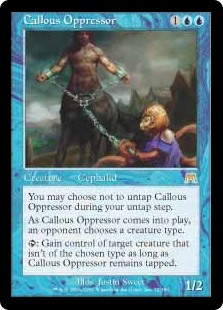
(Onslaught/Legions/Scourge)
Onslaught was the tribal block, so creature type mattered a lot. Sure, your opponent might have ten beasts in their green deck, but Callous Oppressor would still be able to steal their four goblins, three elves, and two other creatures that weren't beasts. Callous Oppressor made attacking and blocking nearly impossible for an opponent if they didn't name wisely when it came into play. Plus, most of the bombs in the format were NOT parts of normal tribes: witness the pit fighter legends, Dragons, Angels, and the such. Would your opponent name Angel to keep you from stealing a potential Exalted Angel as you played a third turn Oppressor, or would they name Soldier to protect half the other creatures in their deck?
16. Repulse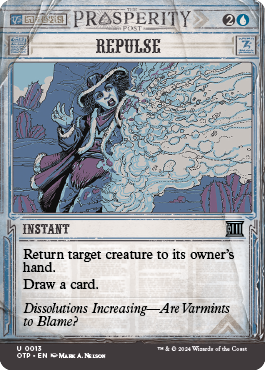
(Invasion/Planeshift/Apocalypse)
Cantrips are fun, since you do not have to spend a card to gain an effect - it breaks the card/mana equation of playing a spell. Repulse took an already good effect (bounce) and added a "draw a card" clause. This turned it from solid card to first pick material.
15. Tims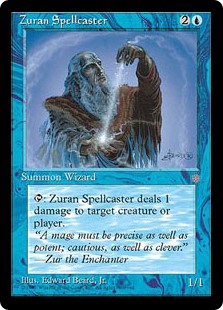
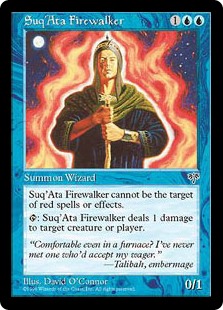
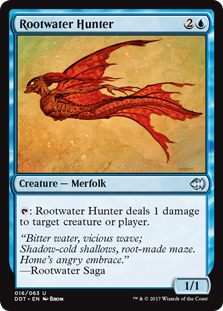
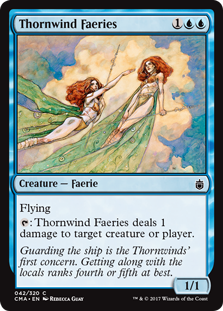
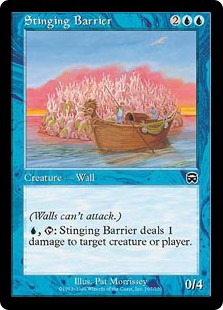
Zuran Spellcaster (Ice Age/Alliances), Suq'Ata Firewalker (Mirage/Visions/Weatherlight), Rootwater Hunter (Tempest/Stronghold/Exodus), Thornwind Faeries (Saga/Legacy/Destiny), Stinging Barrier (Masques/Nemesis/Prophecy)
Psionic Gift and Hermetic Study are fine, but they require a two card investment: the creature you are enchanting, and the enchantment itself. If the creature is removed, you lose card advantage. These creatures from various blocks all served the same purpose as the Study/Gift, but at the cost of one card and three mana (or four mana in the case of Stinging Barrier). Some were more important than others: For instance, Stinging Barrier was a first pick in its block, since the block was slow, creatures had low toughnesses, and low powers. Rootwater Hunter wasn't as important as the wall, but would make your deck every time none-the-less. It's just hard to get as excited about a one toughness Tim when a format is filled with a billion and a half removal spells in the common slot, and where you can already be at five life by the time your Tim becomes active! A general rule: the slower the format (Ice Age/Masques/Odyssey), the more valuable the Tim.
14. Undo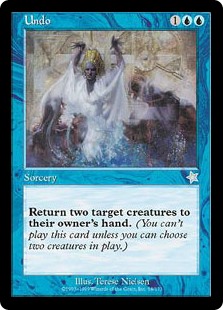
(Mirage/Visions/Weatherlight)
Each block has a different threshold of development. This means that by turn "X," if you don't have a creature to drop, you are going to fall behind on board development. In Onslaught Block, this is turn three (the morph turn). In Tempest, it was turn one (Mogg Fanatics, shadow creatures, and flyers), Invasion turn two (2/2 bears for every possible color combination plus several one- and two-mana apprentices and utility creatures), and Mirage turn three. Every single color had three mana "Grey Ogres" (2/2's for three mana) and four mana "Hill Giants" (3/3's for four mana). Undo allowed you to completely break the symmetry of the format: you would play a turn three 2/2, your opponent would play a turn three 2/2. You'd play a turn four 3/3, your opponent would play a turn four 3/3. You would play a turn five Undo, and win the game. What's an opponent supposed to do? Suddenly you have five power worth of creature on the board against their empty territory. Even late game, Undo could take out two key blockers allowing for your creatures to swing in for that last few damage.
13. Wizard Mentor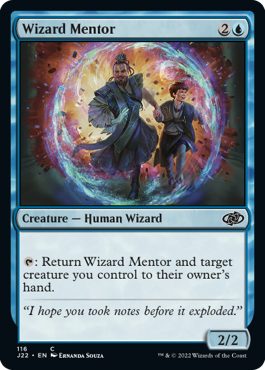
(Saga/Legacy/Destiny)
An interesting thing occurred at the last third of Urza Block limited: Wizards of the Coast changed the rules of Magic. Suddenly, combat damage stacked and effects could happen before said damage was dealt. Before this change, Wizard Mentor was a first pick card which could save your creatures from creature kill spells, allow you to reuse the bevy of 187 creatures in the format (Ghitu Slinger, anyone?), and at worst case scenario allow you to play emergency defense. After the changes to combat damage, Wizard Mentor became absolutely insane, allowing you to attack and block with complete and absolute impunity, since you could stack combat damage and save your creatures at will.
12. Man-o'-War
(Mirage/Visions/Weatherlight)
Undo and Man-o'-War were often seen together in packs, and players debated which was better: the sorcery which took out two creatures, or the 2/2 creature which took out one. Both cards gave you a two creature swing on your opponent, either with you plus one and them minus one, or them minus two. In the end though, Man-o'-War was seen as the better of the two since it could itself attack and kill an opponent, unlike Undo. In addition, it could potentially be reused if you had additional bounce spells. Many games went Man-o'-War your turn 3 creature, Man-o'-War your same creature on turn 4, Undo your same creature and one of my Man-o'-Wars on turn 5, Man-o'-War the creature yet again on turn 6. These games didn't tend to last long for your opponent.
11. Exclude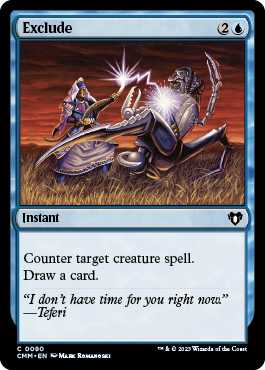
(Invasion/Planeshift/Apocalypse)
If Repulse was good, Exclude was the nuts. For only one more mana than Remove Soul, you outright countered any creature your opponent cast, plus got to draw a card! Remember when I said that holding back development for counterspells was generally a bad idea in limited? Since Invasion's creature wars usually began on turn two, you could drop a turn two bear, and then hold back Exclude for anything your opponent might drop.
10. Sigil of Sleep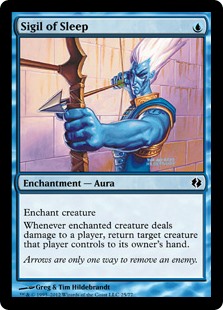
(Saga/Legacy/Destiny)
We're into the top ten now, and here comes the bounce full force! In most limited formats, Blue is the color with the most evasion creatures. Urza's Block was no exception to this rule, so Sigil on a flyer often equaled doom for a hapless opponent, as their best creature went home every turn. Wait, did I say flyer? I meant any creature capable of dealing damage, from Thornwind Faeries to anything with a Hermetic Study. Losing a creature a turn is a hard pill for an opponent to swallow, especially once it costs you no investment past the initial one mana and one card.
9. Tradewind Rider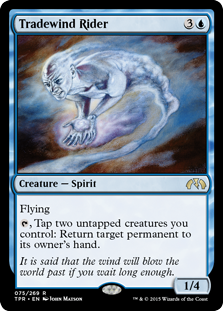
(Tempest/Stronghold/Exodus)
Tradewind Rider was too tough for its own good. And by this I mean that four toughness was a lot for a four mana flyer with an already game-breaking ability. This extra toughness made Tradewind Rider nigh unkillable, and once it hit the board, it could completely dominate for all the reasons that reusable bounce dominates limited games as outlined above.
8. Waterfront Bouncer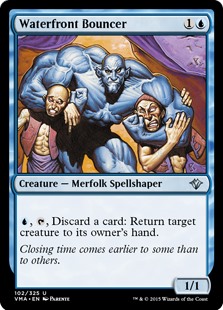
(Masques/Nemesis/Prophecy)
The best non-rare Spellshaper, Waterfront Bouncer was perhaps the most powerful common in the format in and of itself. Masques Block was a reaction to the overpowered Saga Block, and for every ounce of "too-good" in Saga was a pound of "not-good-enough" in Masques. This made for a misfit assortment of bad creatures that were given the task to win the game against an army of Rebels, a super-efficient creature type in any non-Tempest block. Waterfront Bouncer was an exception to this rule, able to turn all of those bad cards you were forced to play into bounce spells. In addition, the Bouncer hit the board on turn two, and could protect himself thereafter. Red removal spells such as Lunge and Shock Troops were turns too late to keep the Bouncer offline, and so a smart player could basically keep his Bouncer around indefinitely, use it to dominate the board, and ride it straight to victory.
7. Alexi, Zephyr Mage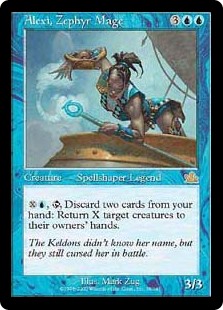
(Masques/Nemesis/Prophecy)
Here's the difference between Odyssey Block and Masques Block: There weren't a lot of spells that could kill a three toughness creature in Masques Block, where there are quite a few in Odyssey Block. This makes Alexi almost impossible to kill, and so she can wreak havoc with the opponent's board each and every turn. At the cost of two cards, you can keep an entire board free of creatures. How many turns of attacking with a horde of your own creatures against an empty board do you need to win? Because of this Alexi was one of the most highly coveted bombs in a format lacking in bombs.
6. Viscerid Drone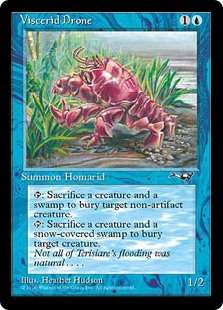
(Ice Age/Alliances)
For all this talk of curve, first turn of creature threshold, and the such, I've not really mentioned Ice Age/Alliances. Unlike later blocks (block formatting began officially with Mirage), Ice Age and Alliances were imagined as one set broken up into two different sets. While I'm not sure what that has to do with anything I'm talking about, I'm sure it would explain why none of the cards work well together. For anyone whose ever played Ice Age/Alliances limited, you'd know what I'm talking about. Everything is just a hodge-podge of spells. You never really end up with a deck, as much as a collection of removal spells, a dash of evasion creatures, a trick or two, and some ground-pounders. Back way when, Wizards didn't really make sure that there were ENOUGH playable limited cards in the common slots for sets (no one was playing much limited before the inception of the Pro Tour, around the release of Ice Age), so horribly unplayable cards like Snowfall and Balduvian Shaman glutted the common slots of packs - and commons are where most of the meat of your limited cardpool comes from! In this format more than any other, reusable removal spells were at a premium, such as Skull Catapult and Stormbind. One such of these spells was Viscerid Drone, which at the cost of two for one against your favor could take out virtually any creature in the format. Trading your worst creature in a format where 90% of your creatures were bad for your opponent's best creature when they might have 2-3 good creatures to win with cannot be undervalued.
5. Opposition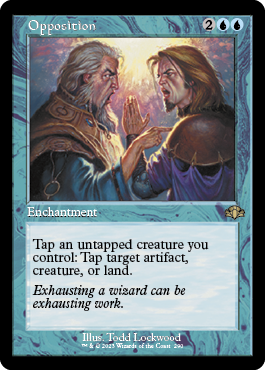
(Saga/Legacy/Destiny)
Now this is everything that Aboshan wasn't: unkillable tapping creatures on a rampage. Every single one of your creatures becomes an Icy Manipulator. Enchantments are the hardest type of permanent to remove in limited aside from lands. Suddenly your opponent can't attack with him good creatures, or block with his good creatures, while you are free to send your happily into the red zone. Any questions?
4. Ray of Command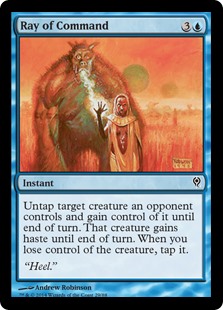
(Ice Age/Alliances & Mirage/Visions/Weatherlight)
The quintessential combat trick in all of limited Magic, Ray of Command was a first pick card virtually on the caliber with red X-spells back when they were common. No, that's not a typo. When faced with the choice between Kaervek's Torch and Ray of Command, Ray of Command would often be the correct first pick. Sure, Kaervek's Torch can kill one creature or be sent to the dome for the win, Ray of Command would generate at minimum two-for-one card advantage every time it was cast. If your opponent attacked with two 3/3's, he would both be dead. If your opponent played a creature with a tap ability, you'd be able to grab it with haste, and use that ability before them. And in the worst case scenario, you could grab an opposing blocker and turn it into your attacker so your forces could come in for the win. There is no common card that needed to be "played around" more than Ray of Command in Magic limited history, and the stories of getting 3-for-ones, 4-for-ones, or even 5- or 6-for-ones with Ray of Command were not unheard of.
3. Upheaval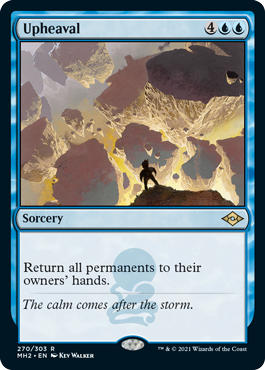
(Odyssey/Torment/Judgment)
Odyssey Block is a slow format where games can and have gone to deckings with some frequency. That's why Upheaval is such a bomb: there are virtually no ways to deal with it, and once it is cast you can end up with two to three creatures plus a land on the board while your opponent literally has nothing, and has a hand full of sixteen cards they need to discard down to seven. When a player sets up an Upheaval, there are very few instances they should lose. Any card which says "cast this, win the game" deserves a top-three slot on a "best of all time" checklist.
2. Morphling
(Saga/Legacy/Destiny)
Every format has a couple of bomb rares where *THAT CARD* is the one card they want to open. In Saga/Legacy/Destiny, there were three such cards: Phyrexian Processor, Masticore, and Morphling. In a format laden with game-turning and ending bombs, Morphling still stood heads and shoulders above the rest as probably the best creature in limited of all time. He could attack, block, had evasion, couldn't be killed, and after the Sixth Edition rules changes could attack, kill and live, and block, kill and live. When an opponent cast a Morphling, you generally had one option: kill them before Morphling single-handedly killed you. That was it. That's power.
1. Capsize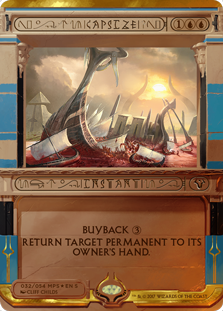
(Tempest/Stronghold/Exodus)
Capsize wasn't just blue's best card in Tempest/Stronghold/Exodus, it *WAS* blue. As in, if you didn't have Capsize, you had no business playing the color. Entire decks were built around Capsize, and we're talking limited here! Able to deal with virtually any problem, Capsize couldn't be dealt with through conventional means (you'd usually have to kill your own creature to have a chance of fizzling Capsize). Need to remove a blocker - or multiple ones? Use Capsize. Need to remove an attacker - or multiple ones? Use Capsize. Opponent slow on the mana development? Use Capsize to lock down their lands the rest of the game. In a format where everything was speed, speed, speed, Capsize single-handedly allowed blue to stay in the game, and eventually lock it up by returning two lands a turn to a hapless opponent's hand. There has never been blue common which so defined an entire color in a limited format, and for that Capsize is my #1 blue limited card of all time.
But wait, that's not all!
The Top 50 Blue Constructed Cards of all Time!
This time around I did a limited list instead of a constructed list because the constructed blue list would have been utterly boring. I've already covered a vast majority of the cards on the constructed list between my best instants and best card-drawing cards articles, so anything I might have to say about 50-60% of the cards on this list would be redundant. On the other hand, I would feel remiss in my duties as Magic Historian if I didn't include a Top 50 constructed list for the sake of posterity.
As usual, some rules:
- All rankings are my personal opinion.
- Some cards have moved up or down on the list compared to where they were on the instants and card-drawing list. This is because Magic is an ever-changing game where new cards introduced into the environment make older cards more or less valuable. This list reflects those changes.
- No gold cards. Sorry, Psychatog.
- There are some comments below, just not for every card.
- There are nine types of blue cards that made this list. They are as follows:
- Bounce = A card that returns a permanent to your opponent's hand.
- Combo = A card that is a piece of a combo deck.
- Counter = A counterspell.
- Creature = A creature, duh.
- Draw = A card that lets you draw more cards.
- Hoser = A card that hoses an opponent's strategy.
- Steal = A card that lets you steal something from your opponent.
- Turn = A card that lets you take extra turns.
- Tutor = A card that lets you search your deck for a specific card.
Anyhow, onto this list!
50. Power Artifact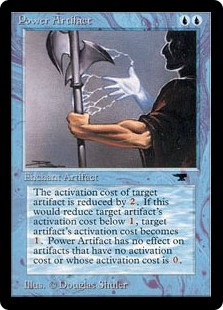
(Combo)
Power Artifact + Grim Monolith = Infinite mana.
49. Palinchron
(Combo, Creature)
48. Hurkyl's Recall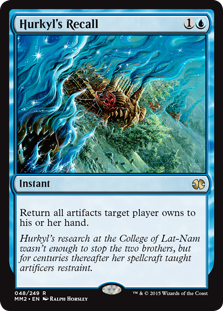
(Combo)
47. Accumulated Knowledge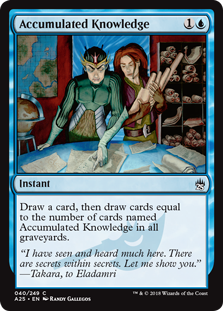
(Draw)
46. Gilded Drake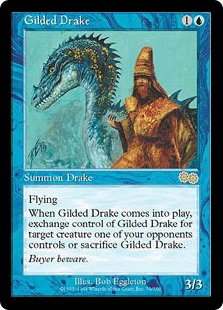
(Steal)
45. Careful Study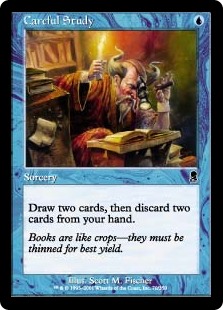
(Draw)
44. Deep Analysis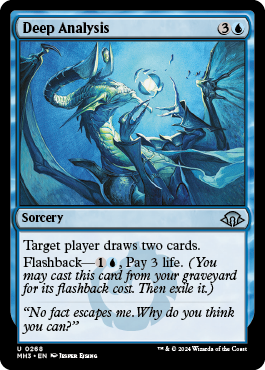
(Draw)
43. Back to Basics
(Hoser)
Perhaps the best non-basic land hoser in all of Magic, depending if you consider Wasteland a hoser or just a good land destruction effect.
42. Merchant Scroll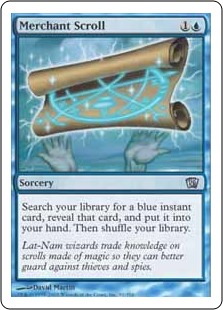
(Tutor)
41. Propaganda
(Hoser)
40. Whispers of the Muse
(Draw)
39. Windfall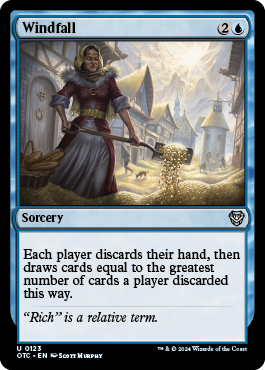
(Combo, Draw)
38. Control Magic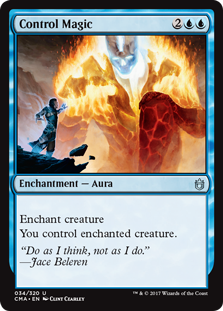
(Steal)
37. Wonder
(Creature)
36. Forbid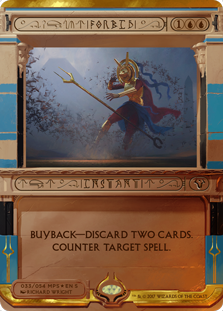
(Counter)
35. Blue Elemental Blast/Hydroblast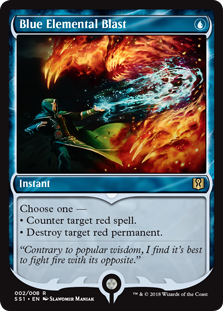
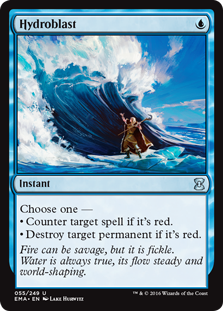
(Counter, Hoser)
Grouped together because they are virtually indistinguishable in purpose, even though they target differently.
34. Mystical Tutor
(Tutor)
33. Circular Logic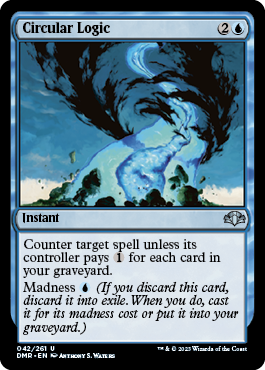
(Counter)
32. Cunning Wish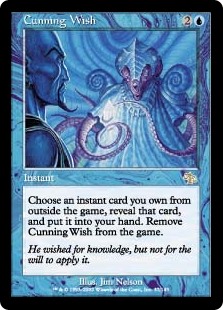
(Tutor)
31. Man-o'-War
(Bounce, Creature)
30. Mind Over Matter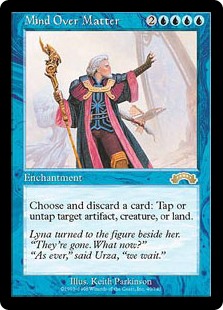
(Combo)
29. Intuition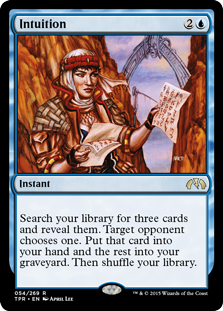
(Tutor)
28. Braingeyser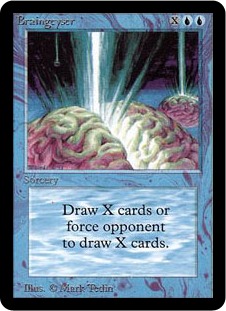
(Draw)
27. Serendib Efreet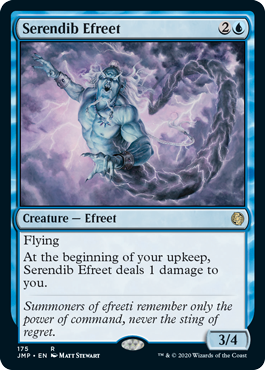
(Creature)
So good that it was banned along with Juggernaut and Kird Ape in Extended since the inception of the format. Sure, Wizards might have allowed Hypnotic Specter for a while (it was eventually banned) and banned Serendib Efreet, but I'm not bitter.
26. Gush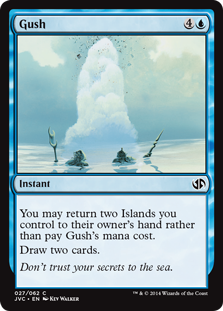
(Draw)
25. Time Warp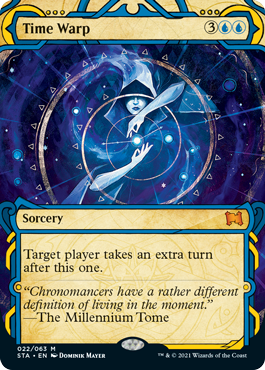
(Turn)
24. Ophidian
(Creature, Draw)
23. Mind's Desire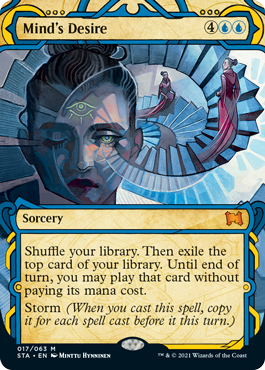
(Combo, Draw)
Restricted in Type 1 before it was even tournament legal. Not yet broken in any other format, but threatening to be broken none-the-less.
22. Treachery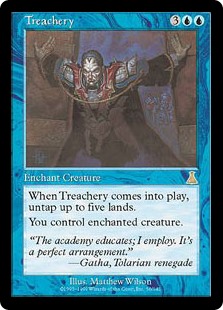
(Steal)
21. Brainstorm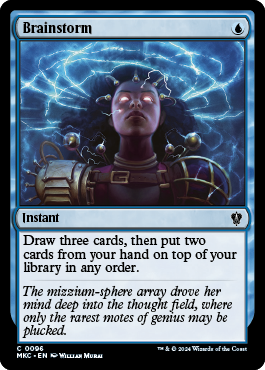
(Draw)
20. Impulse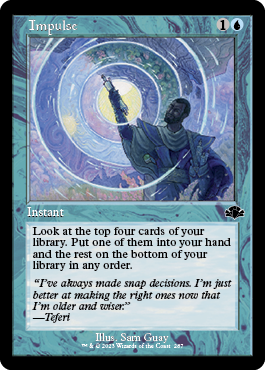
(Draw)
19. Dream Halls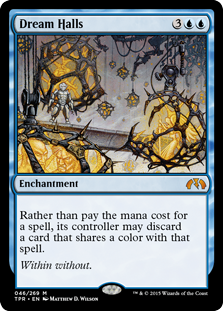
(Combo)
Long ago, InQuest Magazine rated this as the worst card in Stronghold. Zvi Mowshowitz built a combo deck around it that so dominated both that it needed to be banned almost immediately after the inception of his deck.
18. Time Spiral
(Combo, Draw)
17. Tradewind Rider
(Bounce, Creature)
16. Opposition
(Hoser)
15. Upheaval
(Hoser)
14. Fact or Fiction
(Draw)
13. Stasis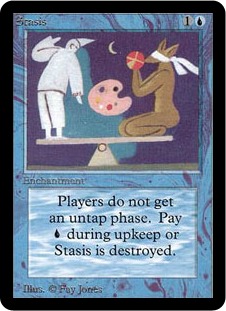
(Hoser)
Probably the single most frustrating card in Magic to play against that doesn't involve killing someone on the first turn with a massive combo.
12. Capsize
(Bounce, Combo)
11. Misdirection
(Counter, Hoser, Steal)
10. Donate/Illusions of Grandeur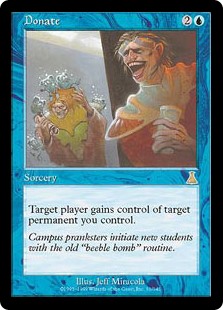
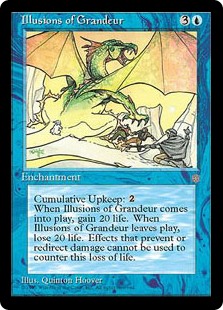
(Combo)
Individually, both of these cards wouldn't even be in the Top 50. They have fed each other symbiotically in virtually every format, and therefore are together here as well.
9. Stroke of Genius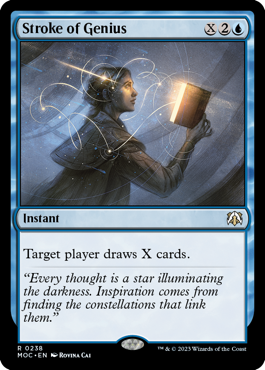
(Combo, Draw)
8. Timetwister
(Draw)
7. Time Walk
(Turn)
6. Tinker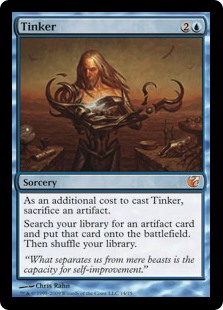
(Tutor)
5. Morphling
(Creature)
One of the best five creatures in Magic, but only the fifth best blue card. Would Psychatog fare better on the gold list?
4. Counterspell
(Counter)
Remained in print way longer than most cards at this power level.
3. Mana Drain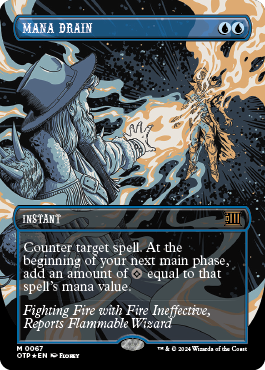
(Counter, Steal)
R&D once said that they would all need to be run over by a bus before they reprinted Mana Drain. As of yet, there have been no R&D-related bus fatalities.
2. Force of Will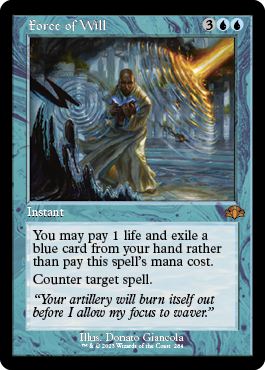
(Counter)
Sometimes referred to as the "glue that holds Type 1 together." Not a small task!
1. Ancestral Recall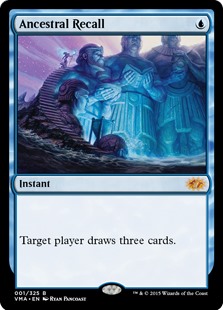
(Draw)
Go figure.
Ben may be reached at bleiweiss1@cox.net.